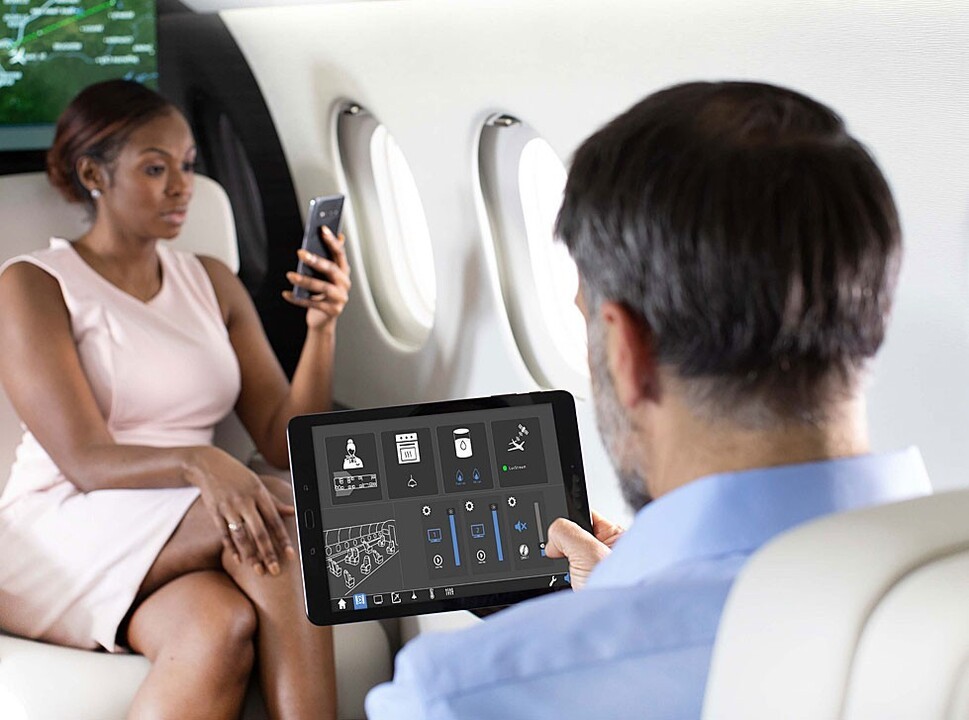- 13 Apr 2022
- Brian Wilson
- Jet Connectivity
Tips on Forward-Thinking CMS Upgrades
When you’re installing a new cabin management system, what can you do to ensure it will be able to handle future advances in technology and functionality? Chris Kjelgaard asks some of the CMS experts.
Back to Articles
One way private jet owners and operators can keep ahead of the curve regarding their Cabin Management System functionality is to keep a focus on the priorities of the system providers.
It is clear to the experts who design, manufacture and sell cabin management systems (CMSs) for business aircraft that one technological factor will be of overriding importance throughout the foreseeable future as CMS design and functionality continues to evolve. That technological factor is broadband wireless connectivity to and within the cabin.
The extent to which Wi-Fi is available throughout the cabin — in terms of the bit-rate it provides, and how reliably it does so wherever the aircraft flies — will determine how well the CMS will function, and the extent of the capabilities it will offer each passenger.
In-cabin consumption of broadband connectivity is still expensive today, but continuing advances in satcoms coverage and capability, and in the growth of terrestrial 5G cellular communications networks, are leading CMS manufacturers to assume “that at some point the aircraft will be able to get [broadband connectivity] affordably and reliably wherever in the world it may be”, according to Steve Scarlata, Co-Founder of Alto Aviation and the company’s VP of Engineering/Research and Development.
Today’s business aircraft fliers are accustomed to everyday use of smart devices — ranging from security systems to floor cleaners, or from lighting systems to digital personal assistants in their homes. Now they are expecting smart systems to become similarly ubiquitous in their aircraft, says Stephanie Cooper, Product Marketing Manager for Cabin Solutions in Collins Aerospace’s Business & Regional Aviation Division.
Making sure that can happen reliably, and in a cohesive manner, is not a simple matter, says Cooper. For one thing, future CMSs will probably employ artificial intelligence software systems which make use of machine-learning predicive algorithms.
They will do so to predict ahead of each flight the preferences of each passenger for parameters such as lighting, sound, cabin temperature, entertainment, and dining, and will relay each passenger’s individual preferences to the cabin attendants, to allow a highly individual service to be provided.
But even more important to the typical business aircraft flier is being able to maintain a high level of privacy within the cabin.
The advent of new cabin technologies – such as voice control and gesture control, relaxation-promoting audio and lighting combinations, seat-to-seat audio communication, and high-resolution videoconferencing – involves the use of audio, motion, and video sensors. In the cabins of tomorrow, the anticipated presence of many smart sensors creates important implications for passenger privacy.
You don’t want the cameras always on you, or microphones picking up and recording your every word, notes Don Hamilton, the other Co-Founder of Alto Aviation, and its President.
While probably typical of future CMS capabilities, the services listed above will by no means represent all the functions that future new, or thoughtfully upgraded, CMSs will offer.
At the very least, CMSs in years to come will need to provide enough Wi-Fi bandwidth, and the cabin router enough interfacing and switching capability, to allow passengers to use apps on their personal devices to control any cabin function handled by the CMS.
What, then, can owners do now to ensure they can upgrade their aircraft’s CMS to be able to incorporate the increased functionality, flexibility, and bandwidth that future technological developments will bring?
Tip 1: Learn if and How Your CMS Can be Grown
Many business aircraft are operating with CMSs which are obsolete. A good test of obsolescence is to determine how easy it is to obtain replacement parts for any failed components of your CMS. The harder it is to find such parts, the more obsolete your CMS is.
If your aircraft has an obsolescent CMS, your choices are either to keep operating the aircraft as it is; try to sell it; or pay to have a new, upgradeable CMS installed.
Assuming your aircraft’s CMS is not obsolete, the next step is to understand if, and how, the CMS can be grown. Unless you are technically expert in the design and performance specifics of your aircraft’s systems, you should ask the CMS manufacturer about the system’s capabilities, and how those can be modified or enhanced to incorporate new functionality and increased Wi-Fi bandwidth in the future.
When asking such questions, owners should be aware that while in some cases CMSs can incorporate individual, powerful, connected electronic devices, these are likely to become obsolete more quickly than are more run-of-the-mill units, according to Scarlata.
It is also important for the aircraft owner to have a clear view of what capabilities the upgraded CMS needs to have, and that depends both on the aircraft’s performance characteristics, and on how the owner intends to use the aircraft. “A charter customer has different [CMS] needs to a family using the jet,” says Scarlata.
In most cases, the real heart of a CMS and the real gauge of how upgradeable it is lies in the software which controls the functions, along with the system’s master control unit (which interfaces to the various switches controlling cabin lighting, temperature, etc.) and the interface controller.
This unit controls inputs from, and outputs to, any modular interfaces tied to units or devices which provide various cabin functionalities, such as an audio/video on demand (AVOD) application embedded with a controller in a bulkhead monitor, or a receiver which allows any personal electronic device carried by a passenger to control various CMS functions using Bluetooth wireless capability.
The control software, the control units, and the associated switches and wiring linking together all the visible parts of the CMS — such as its video screens, audio speakers and side-panel or in-seat environmental controls — make up what technicians call the “backbone” of the CMS.
CMS backbones also include items such as Ethernet optical-fiber connectors, HDMI-to-3G FDI video converters, and software transfer protocols that make the upgrade paths possible in the first place. “A lot more of the [monetary] value of the CMS is underneath the floorboards” of the cabin in the hidden control units and interfaces than many owners realize, she says.
Instead of upgrading the entire CMS all at once, many owners choose to install “point solutions” to improve specific individual CMS capabilities, says Cooper. Such point solutions may include (for instance) installing higher-resolution video monitors or adding controllers to allow the CMS to handle specific additional functionalities.
But the backbone remains the most important part of the CMS and it has to be robust and allow for scalability if the owner wishes to keep upgrading the CMS over the longer term. So, knowing to what extent the CMS backbone can allow the CMS to be scaled up or to incorporate additional functionality is vital to understanding to what degree your CMS can be upgraded.
Tip 2: Know the CMS Manufacturer’s Reputation
When considering a CMS which you believe should be able to handle any conceivable functionality or scalability upgrades over a period of many years, it is just as important for the aircraft owner to know how well the manufacturer of that CMS is regarded for its technical and product support and its R&D capabilities as knowing what the CMS’s current capabilities are.
“The key message for owners is how to prepare” for finally deciding on the CMS they will choose, says Cooper. They need to be sure that the preferred CMS is capable of being upgraded substantially, and supported properly by the manufacturer throughout the period the owner continues to own and operate the aircraft – and even beyond.
A highly functional, still upgradable, well-supported CMS will contribute a respectable proportion of the aircraft’s overall resale price — and the aircraft’s market value is likely to be even higher if the CMS manufacturer is continuing to develop the CMS design and is still introducing improved performance characteristics and functional capabilities.
Aircraft owners should study the CMS manufacturer closely to learn about the company’s CMS business-development direction (in terms of how seriously it is studying new consumer technological trends and investing in developing ways in which their CMSs can incorporate or reflect those trends), says Cooper.
Collins Aerospace makes the best-selling Venue CMS, installed in more than 1,600 in-service aircraft. The Venue system’s backbone provides the infrastructure for the latest technologies to be added, which enables a seamless modular approach for future upgrades.
Collins’ civil-aviation products range from airline seats to landing gear, and from electrical power systems and auxiliary power units to the massive air conditioning and environmental control system in the Boeing 787-10. It makes thousands of systems that go into aircraft, for just about every major aircraft manufacturer in the world.
Even for a company as massive as Collins, however, it takes a major effort to stay fully informed on the rapid advances being made in the consumer electronics sector, as a vital way of understanding what is likely to become important next for CMS functionality.
Collins sends teams of avionics and systems engineers to major electronics trade shows such as the annual Consumer Electronics Show in order to gain a clear idea of potential CMS development paths.
“It takes constant monitoring to have an idea which of those technologies are going to need CMS solutions,” Cooper says. “But it also speaks to the lifespan we want to build into the products we make — making sure we have long-term supportability, and amplifying that experience.”
However, says Hamilton, aircraft owners considering a CMS upgrade shouldn’t restrict their questioning merely to the manufacturer of the system. It serves owners well to also find out what one or more trusted maintenance providers think of the manufacturer’s reputation in that regard.
Following are some questions owners should ask:
- How reactive is the manufacturer to supporting its CMS products in service?
- Does the company offer strong parts and technical support for any obsolescent CMS systems it still has in service?
- How likely is the CMS manufacturer to remain in business in the longer term? (Many aircraft are flying today with obsolete CMS installations simply because the manufacturer went out of business and replacement parts are becoming hard to find.)
After beginning life 25 years ago as a designer and manufacturer of high-quality audio systems for business aircraft (notably Gulfstream models), Alto Aviation subsequently expanded into designing and providing configurable, fully compatible replacement switches and controls for failing or failed OEMs’ obsolescent CMSs.
Continuing development of that product line led Alto Aviation in 2017 to market its own, fully scalable CMS, the Cadence system, available as a whole or as individual replacement components such as switches and control panels.
Alto’s Cadence products have been installed on more than 350 aircraft and more than 5,000 aircraft incorporate Alto Aviation cabin audio and/or other components.
In Summary...
In the final analysis, choosing the right system and the right manufacturer to give an aircraft owner peace of mind when seeking CMS solutions they will be able to upgrade over the longer term “comes down to service engagement”, says Scarlata.
“The service mentality is really the most important aspect,” in differentiating a high-quality, reliable manufacturer from others which might not be as reliable in the long run. “Supporting the customer and the product in timely fashion” is the most important attribute for a CMS manufacturer to have, concludes Scarlata. “Good providers think things out for the best solution in ten years’ time.”
More information from:
Alto Aviation: www.altoaviation.com
Collins Aerospace: www.collinsaerospace.com
Related Articles
- 24 Feb 2022
- Brian Wilson
- Jet Connectivity
- 10 Feb 2022
- Ken Elliott
- Avionics - BizAv


